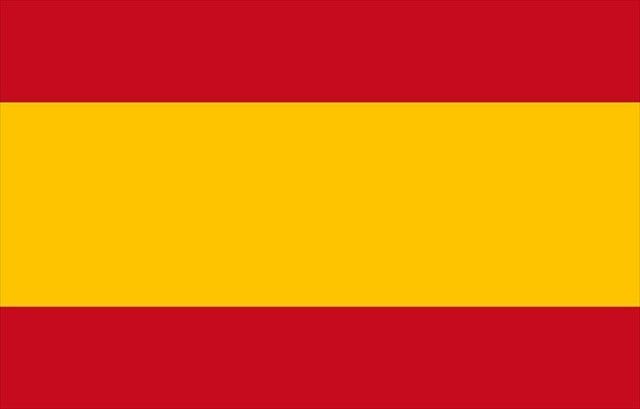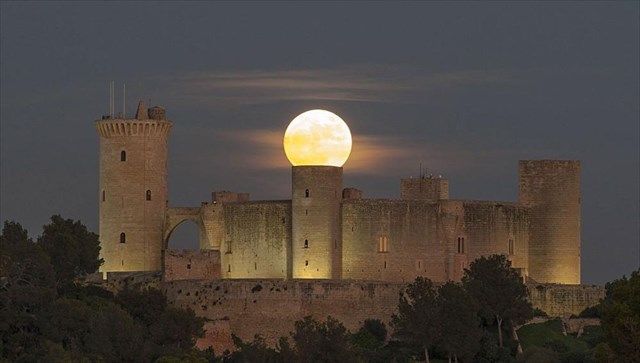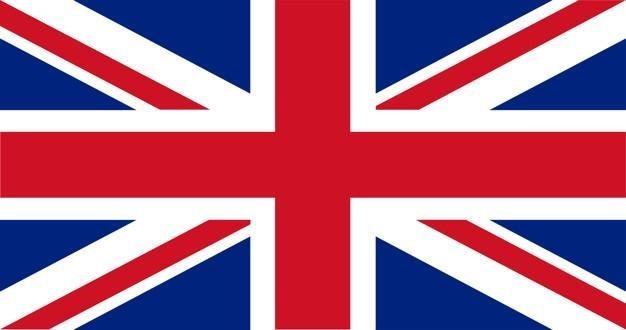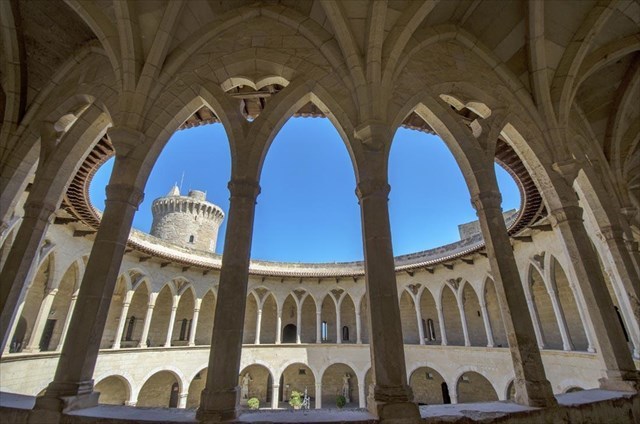

El castillo de Bellver
Entre las construcciones erigidas a lo largo de la historia de Mallorca, el castillo de Bellver, es, sin duda una de las más originales y emblemáticas. El castillo fue construido entre 1300 y 1311 por orden directa del rey Jaime II de Mallorca y está situado a unos 3 kilómetros del centro de la ciudad de Palma, sobre una colina de 112 metros de altura. El recinto responde a un plano muy concreto y bien original. Consta de un edificio de estilo gótico de planta perfectamente circular, que se organiza alrededor de un patio central también circular, con cuatro grandes torres orientadas hacia los cuatro puntos cardinales. La llamada torre mayor o del homenaje, en dirección norte, está exenta del resto del conjunto, mientras que el resto de torres están encastradas al cuerpo principal. Aunque se han intentado buscar precedentes de castillos circulares en los que Bellver podría haberse inspirado, todo indica que la obra mallorquina es una obra innovadora genuina. El material usado en la construcción del castillo de Bellver es marés, un tipo de piedra arenisca fácil de trabajar y que se encuentra frecuentemente en toda la geografía balear. Buena parte de la piedra proviene de las cuevas que se encuentran debajo del castillo, así como de otras canteras del mismo bosque, de Portals Vells y de Santanyí.
Bellver después de 1343
Después de ser usado como residencia real, el castillo de Bellver alojó durante muchos años a las principales autoridades de la isla al tiempo que comenzó a servir como prisión ocasional. A partir de la Guerra de Sucesión (1700-1715) el castillo se convirtió en la principal prisión política y militar de la isla, un lugar especialmente útil cuando se pretendió silenciar la voz e incomunicar a personajes de gran influencia política y social. Importantes personalidades como el intelectual ilustrado Gaspar Melchor de Jovellanos, el astrónomo y político François Aragó o el general liberal Luis Lacy fueron enviados a Bellver. Ya en tiempos de la guerra Civil Española (1936-1939) el castillo vivió los momentos más tristes y amargos de su historia, con el encarcelamiento de más de 800 presos republicanos defensores del gobierno legítimo surgido democráticamente de las urnas.
Revellín exterior
En el mismo siglo XIV se empezó a construir una línea defensiva exterior al castillo, que en los documentos aparece denominada como banc. A mediados del siglo XVI, esta singular obra fue sucesivamente ampliada y adaptada a los progresos de la artillería, debido a la necesidad de incrementar las defensas del puerto y la ciudad. En 1713, en pleno conflicto sucesorio tras la muerte de Carlos II, los partidarios del archiduque Carlos de Austria construyeron una nueva línea defensiva exterior que debía servir para hacer frente al avance de las fuerzas del borbón Felipe de Anjou.
La torre mayor
La torre mayor, perfectamente protegida y aislada del resto de la fortaleza, era el último reducto de resistencia si Bellver era atacado. En este tipo de torres se celebraba, de manera tradicional, la ceremonia de homenaje, por la cual el castellano, como máximo responsable de la fortaleza, realizaba un juramento de fidelidad y obediencia a su rey o señor y se comprometía a defender el castillo. Durante muchos años la torre mayor fue usada también como prisión. Una importante colección de grafitos es la principal prueba de aquel periodo de reclusión.
Interiores del castillo
Es en el interior del castillo donde puede contemplarse toda su grandeza y exquisitez y ver que, aparte como fortaleza, el castillo fue concebido como una residencia real con unos acabados elegantes y refinados. En la planta baja estaban las estancias destinadas básicamente al abastecimiento de Bellver, mientras que en la planta noble se ubicaban las habitaciones y dependencias de la familia real, las salas oficiales para la celebración de reuniones, recepciones y ceremonias, así como la capilla de San Marcos
Los Domingos la entrada al Castillo es gratuita y podrás visitar las diferentes salas museísticas del mismo. De especial interés es el Museo de Historia de la Ciudad y la Sala con la colección de esculturas de la colección Antoni Despuig.

Para loguear este caché:
A) En las coordenadas del caché cuenta los escalones que conducen a la entrada del castillo y mándame la respuesta por Mail o mediante Centro de Mensajes
B) Toma una fotografía, tuya o de tu GPS, frente a estas escaleras con un papel donde indique el nombre de tu equipo. Si no quieres que se vea tu cara fotografía solamente el papel frente a las escaleras de manera que sea claramente legible.
Nota: Los logs que no cumplan los requisitos serán eliminados sin excepción.


Bellver Castle
Bellver Castle is undoubtedly one of the most original, emblematic buildings in Mallorca’s history. It was built between 1300 and 1311 on the instructions of King James II of Mallorca and is to be found some three kilometres from the city centre of Palma, on a hill some 112 metres above sea level. It has a very specific original design, made up of a Gothic building that forms a perfect circle around a courtyard of the same shape, with four big towers facing the four points of the compass. The keep faces north and it is separated from the rest of the castle, while the other towers are buttressed to the main body. Although attempts have been made to find earlier circular castles that may have inspired Bellver’s construction, everything seems to indicate that it is an innovative, genuinely new work of architecture. The material used for building Bellver castle is sandstone, an easily workable material widely found throughout the Balearics. Most of the sandstone was quarried from the caves in the subsoil of the castle, and from other quarries from Bellver woods, Portals Vells and Santanyí.
Bellver Castle post 1343
After being a royal residence, Bellver castle housed the most emblematic figures of the island and it also started to serve as an occasional prison. During the Spanish War of Succession (1700-1715) the castle was converted into one of the island’s main prisons. The castle was especially useful when highly influential political and social figures needed to be silenced and kept in isolation. Prominent people such as the enlightened man of letters Gaspar Melchor de Jovellanos, the French astronomer and politician François Arago or liberal military officer Luis de Lacy were imprisoned at Bellver. During the Spanish Civil War (1936-1939) the castle witnessed some of the saddest and bitterest episodes of its history with the imprisonment of more than 800 republicans, all supporters of the lawfully elected democratic government .
The Ravelin
Work on these outer defences began in the 14th century, with it being documented as a bank. In the mid 16th century, this singular feature was successively enlarged and adapted to fit in with developments in artillery, for the defence of the city and its harbour. In 1713, during the succession conflict after the death of Charles II, supporters of Charles of Austria built a new line of irregular-shaped defences to withstand attacks of the Bourbon Philip of Anjou’s army.
The Keep
The keep, better protected and separate from the rest of the building, was intended as a last resort if a siege were to occur. Traditionally, homage ceremonies were held in this sort of tower, when the keeper of the castle, as the ultimately responsible for the fortress, would swear an oath of fealty and obedience to his lord or king and promise to defend the castle. For many years the keep was also used as a prison. A substantial amount of graffiti is the main proof of it.
The inner rooms
It is inside the castle that its exquisite grandeur can be seen to full effect, while it can also be observed that it was conceived to act as a royal residence as well as a fortress, finished off in refined, elegant style. Originally, the rooms on the ground floor were mainly used for storing supplies. On the upper storey were the royal chambers the official chambers for meetings, receptions and ceremonies, and the chapel of Saint Mark.
On sundays the entrance to the Castle is free and you can visit the different museum halls in it. Of special interest is the Museum of History of the City and the Hall with the collection of sculptures from the cardinal Antoni Despuig Collection.

To log this Caché:
A) At the posted coordinates, please count the steps of the stairs that lead to the Castle entrance and send me your answer by Mail or Message Center.
B) Take a picture of you in front of these stairs with a piece of paper indicating the name of your Team. If you do not want your face to be seen, photograph only the paper in front of the stairs so that is clearly readable.
Note: Logs that not meet the requirements will be erased without exception.
Virtual Rewards 2.0 - 2019/2020
This Virtual Cache is part of a limited release of Virtuals created between June 4, 2019 and June 4, 2020. Only 4,000 cache owners were given the opportunity to hide a Virtual Cache. Learn more about Virtual Rewards 2.0 on the Geocaching Blog.